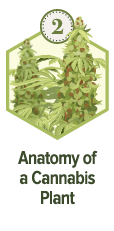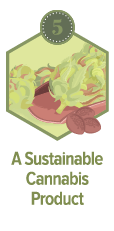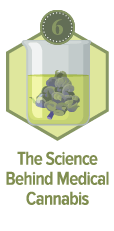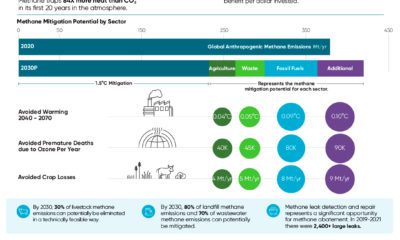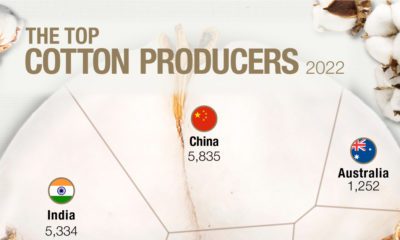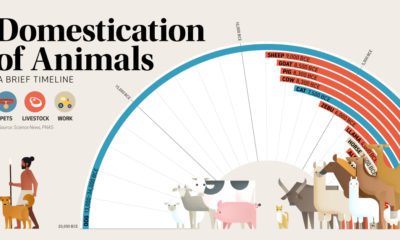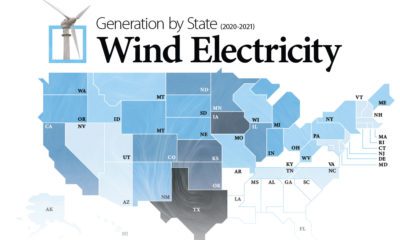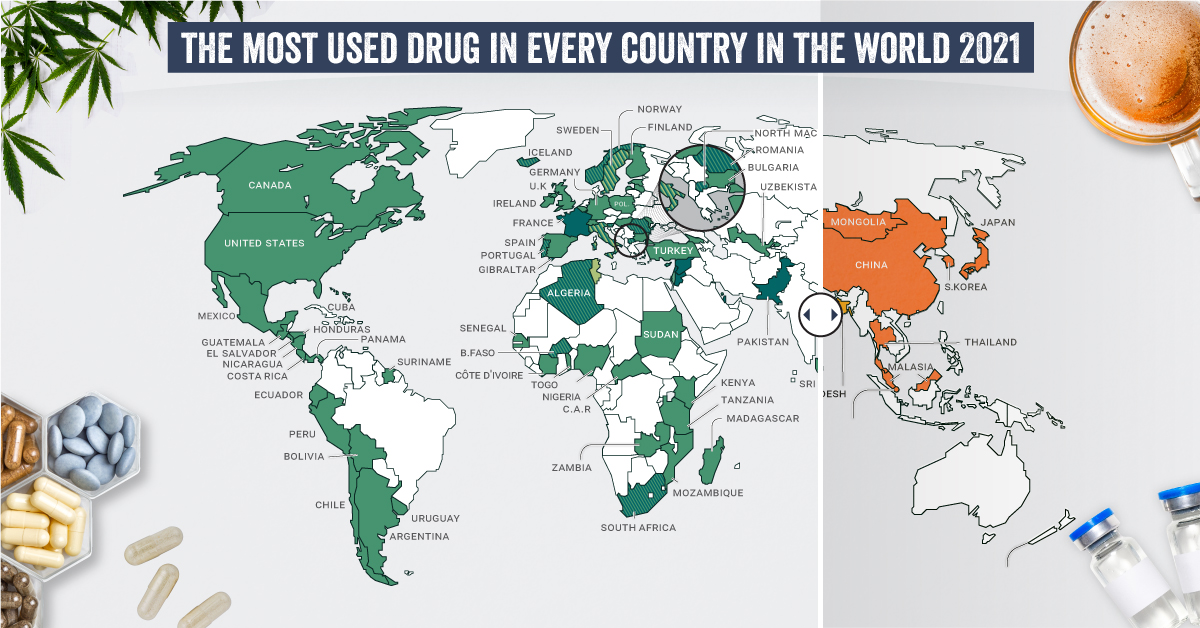That will make it bigger than annual global sales for raw metals like nickel and silver put together. It would be a size that even exceeds the North American pork market. But while almost everyone has a sense of the basic mechanics of mining or ranching, knowledge around the essentials of cannabis are understandably not as well ingrained in our culture.
Cannabis Plants 101
Today’s infographic comes to us from The Green Organic Dutchman, and it breaks down the anatomy of a cannabis plant, the differences between types of plants, and also the basics around cannabis cultivation.
Here are some of the more important things you need to know about the plant:
Plant Anatomy Commercial cannabis comes from the female species, which have long skinny stems and large, iconic fan leaves. The plant is trimmed down into buds, which come together in a cola at the top of the stem.
Trichomes are a blanket of crystal resin coating the cannabis plant, and they contain both terpenes and cannabinoids.
Cannabinoids The two most well-known cannabinoids are THC and CBD, which also occur in the largest volume.
Delta-9-tetrahydrocannabinol (THC) is known to cause psychoactive effects or the “high” felt from cannabis. Effects: pain relief, anti-nausea, sleep aid, appetite and mood stimulant.
Cannabidiol (CBD) lacks nearly any psychoactive effect, making it preferred as a medicine. Effects: pain relief, anti-nausea, anti-inflammatory, anti-anxiety, seizure reduction.
Other cannabinoids such as cannabichromene (CBC), cannbigerol (CBG), and cannabinol (CBN), have similar therapeutic properties. Research is also validating the plant’s efficacy in treating medical conditions such as cancer, multiple sclerosis, PTSD, and Alzheimer’s.
Terpenes Terpenes are organic, aromatic compounds found in the oils of all flowers, including cannabis. Interestingly, these oils have their own independent medical potential that is waiting to be unlocked.
Cannabinoids and terpenes work in harmony, resulting in an “entourage effect” and enhances the medical properties of cannabis
Sativa, Indica, Hybrid There are two common types of cannabis plants: sativa and indica.
Sativa plants have long and thin leaves that are lighter in color. Buds are long and wispy, and feature red or orange coloring. They tend to contain high THC and low CBD levels – optimal for daytime use, described as being energizing, stimulating, and creative.
Indica plants have leaves that are wide, broad, and deep in color. Buds are dense and tightly packed, featuring purple coloring. Indica usually contains medium levels of THC, and a higher amount of CBD. Its effects are often described as being relaxing and calming, which is more optimal for nighttime use.
It’s also worth noting that hybrid strains can often bring together the best qualities of both into one plant.
The Lifecycle of a Cannabis Plant
Every stage of growth of a cannabis plant needs different care:
- Germination (Seed): 1-2 weeks Seeds ready for germination are dark brown, hard, and dry. Encourage sprouting by watering seeds in a paper towel.
- Seedling: 2-3 weeks Move seeds into growing medium. Plants need the maximum light at this stage, and appropriate water levels. Cotyledon (seed leaves) and iconic fan leaves will grow. Light: 18-24 hours Humidity: 70% Temperature: 20-25°C
- Vegetative: 2-8 weeks Plants need flowing dry air, fresh warm water, and increased nutrients – especially nitrogen. It’s important at this stage to separate male and female plants before pollination to prevent female plants producing seeds instead of trichomes. Light: 12 hours sunlight (18 hours fluorescent light) Humidity: 50% Temperature: 20-24°C
- Flowering: 6-8 weeks Gradually reduce light exposure to produce medicinal qualities. Increase phosphorous levels and decrease nitrogen. Fertilizers can help stimulate bud formation. Light: 12 hours Humidity: 40-50% Temperature: 20-28 °C
- Harvesting Trim and dry the buds. The plant is ripe when buds turn from milky white to reddish orange. Harvest once 70-90% of pistils are browned for maximized taste and effect. Humidity: 50% Temperature: 20-25°C As the cannabis industry matures, consumers will demand the highest-quality products. Growing cannabis in a natural environment is increasingly vital to create a premium end-product. In the next part of this series, we will dive into various growing methods and the benefits of organic methods on quality and effects of cannabis. on Humans have a storied and complicated relationship with drugs. Defined as chemical substances that cause a change in our physiology or psychology, many drugs are taken medicinally or accepted culturally, like caffeine, nicotine, and alcohol. But many drugs—including medicines and non-medicinal substances taken as drugs—are taken recreationally and can be abused. Each country and people have their own relationship to drugs, with some embracing the use of specific substances while others shun them outright. What are the most common drugs that are considered generally illicit in different parts of the world? Today’s graphics use data from the UN’s World Drug Report 2021 to highlight the most prevalent drug used in each country.
What Types of Common Drugs Are Tracked?
The World Drug Report looks explicitly at the supply and demand of the international illegal drug market, not including commonly legal substances like caffeine and alcohol. Drugs are grouped by class and type, with six main types of drugs found as the most prevalent drugs worldwide.
Cannabis*: Drugs derived from cannabis, including hemp. This category includes marijuana (dried flowers), hashish (resin), and other for various other parts of the plant or derived oils. Cocaine: Drugs derived from the leaves of coca plants. Labeled as either cocaine salts for powder form or crack for cocaine processed with baking soda and water into rock form. Opioids: Includes opiates which are derived directly from the opium poppy plant, including morphine, codeine, and heroin, as well as synthetic alkaloids. Amphetamine-type Stimulants (ATS): Amphetamine and drugs derived from amphetamine, including meth (also known as speed), MDMA, and ecstasy. Sedatives and Tranquilizers: Includes other drugs whose main purpose is to reduce energy, excitement, or anxiety, as well as drugs used primarily to initiate or help with sleep (also called hypnotics). Solvents and Inhalants: Gases or chemicals that can cause intoxication but are not intended to be drugs, including fuels, glues, and other industrial substances.
The report also tracked the prevalence of hallucinogens—psychoactive drugs which strongly affect the mind and cause a “trip”—but no hallucinogens ranked as the most prevalent drug in any one country. *Editor’s note: Recreational cannabis is legal in five countries, and some non-federal jurisdictions (i.e. states). However, in the context of this report, it was included because it is still widely illicit in most countries globally.
The Most Prevalent Drug in Each Country
According to the report, 275 million people used drugs worldwide in 2020. Between the ages of 15–64, around 5.5% of the global population used drugs at least once. Many countries grouped different types of the same drug class together, and a few like Saudi Arabia and North Macedonia had multiple different drug types listed as the most prevalent. But across the board, cannabis was the most commonly prevalent drug used in 107 listed countries and territories: How prevalent is cannabis worldwide? 72 locations or more than two-thirds of those reporting listed cannabis as the most prevalent drug. Unsurprisingly these include countries that have legalized recreational cannabis: Canada, Georgia, Mexico, South Africa, and Uruguay.
How Common Are Opioids and Other Drugs?
Though the global prevalence of cannabis is unsurprising, especially as it becomes legalized and accepted in more countries, other drugs also have strong footholds. Opioids (14 locations) were the most prevalent drugs in the Middle-East, South and Central Asia, including in India and Iran. Notably, Afghanistan is the world’s largest producer of opium, supplying more than 90% of illicit heroin globally. Amphetamine-type drugs (9 locations) were the third-most common drugs overall, mainly in East Asia. Methamphetamine was the reported most prevalent drug in China, South Korea, and Japan, while amphetamine was only the most common drug in Bangladesh. However, it’s important to note that illicit drug usage is tough to track. Asian countries where cannabis is less frequently found (or reported) might understate its usage. At the same time, the opioid epidemic in the U.S. and Canada reflects high opioid usage in the West. As some drugs become more widespread and others face a renewed “war,” the landscape is certain to shift over the next few years.

